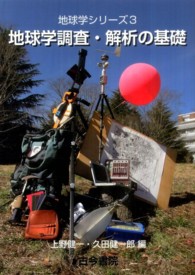- ホーム
- > 洋書
- > 英文書
- > History / World
Full Description
A study of women's lives in the public sphere of the ancient city of Pompeii.
Pompeii's well-preserved remains provide a unique opportunity for the close study of ancient lives. Drawing on statues, inscriptions, graffiti, wall paintings, and the architecture of tombs, sanctuaries, houses, and public spaces, The Lives and Deaths of Women in Ancient Pompeii examines the public lives of women in Pompeii. Art historian Brenda Longfellow explores how historical women of all social backgrounds acted in public and exerted agency on behalf of themselves and others, ultimately finding that female initiatives in Pompeii were not only accepted but desired by the community to a greater extent than has previously been recognized.
Longfellow centers her study on a few key women-including the city's most notable female patron, Eumachia-and uses them to examine female roles in postmortem commemorations, civic patronage and benefactions, commerce, the priesthood, and the home. By following these individuals, Longfellow examines women's lives in Pompeii in both abstract and concrete ways, allowing readers to better understand their importance to the city and society. The result is a groundbreaking book that foregrounds the agency of women in everyday Pompeii.
Contents
List of Illustrations
Introduction. Mulvia Prisca and the Women in Pompeii
Chapter 1. Life after Life: Female Tomb Builders
Chapter 2. Annedia and the First Generation of Tomb Builders
Chapter 3. Eumachia and Her Neighbors
Chapter 4. Funerary and Civic Honors for Pompeian Women
Chapter 5. Eumachia, Mamia, and the Religious Activities of Pompeian Women
Chapter 6. A Woman's Place? The Domestic Sphere
Chapter 7. Minding Their Own Business(es): Julia Felix, Holconia, and Eumachia in the Economic Life of Pompeii
Acknowledgments
Appendix. Female Tomb Patrons and Supervisors in Pompeii
Notes
Bibliography
Index








